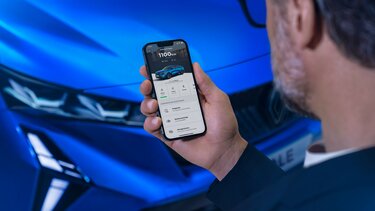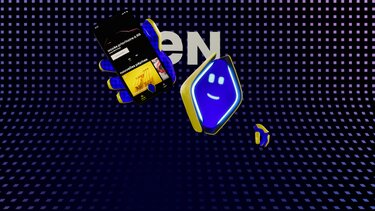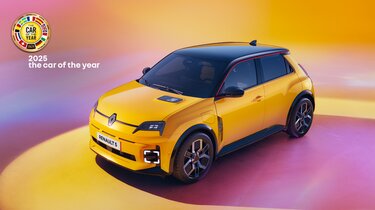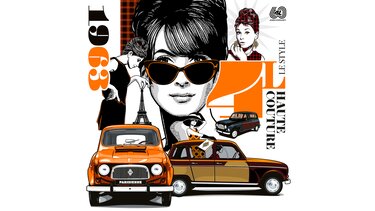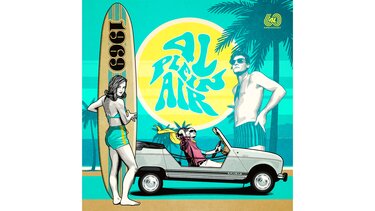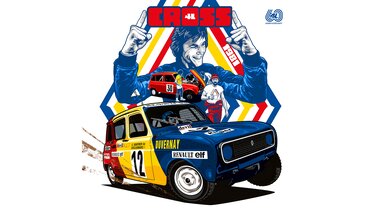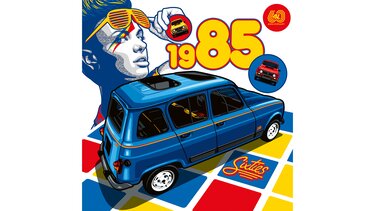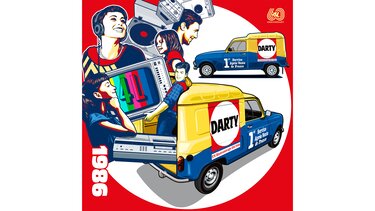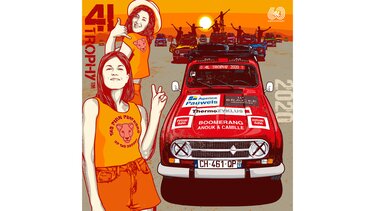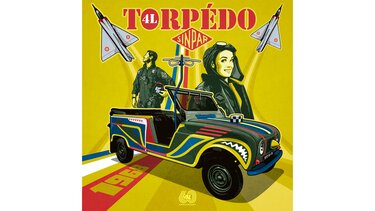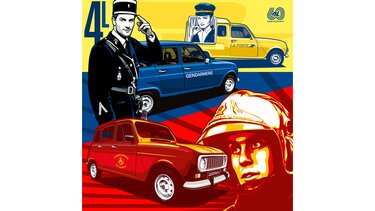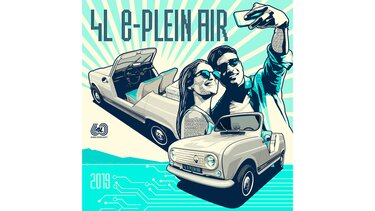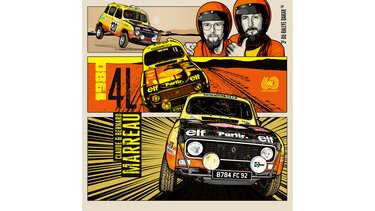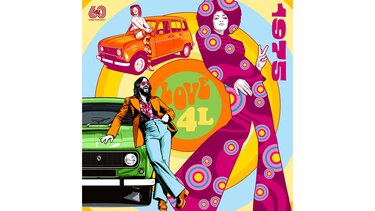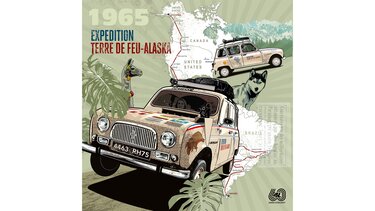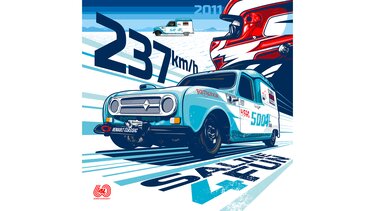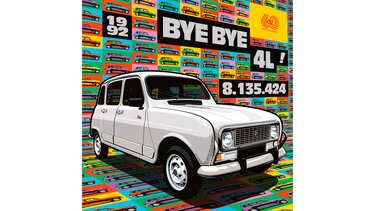4L retrospective: French artist Greg unveils 14 exclusive illustrations
Retrace the 4L success story through 14 creations by French illustrator Greg.
Renault 4L “Haute Couture” - 1963
For the “Elle prend le volant!” (She’s in the driving seat) campaign, a hundred R4 Super cars were dressed in a “Haute Couture” style: black background adorned with a golden cane or plaid pattern on the doors and rear hatch, chrome hubcaps and a reminder of the same motif on the air vent.
During this campaign, 6,000 female drivers were allowed to take an R4 Super for a 48-hour test drive so they could see for themselves how easy it was to handle, how comfortable it was, how much room it could carry, how much visibility it offered and how fast it went!
Each driver gave feedback, observations or suggestions to help establish the ideal profile of the car of the time.
Renault 4L “Plein Air” - 1969
A leisure car designed for driving along the beach rather than on the road,
Renault 4 Plein Air was launched in May 1968 and produced in very small
numbers until April 1970.
It was a convertible torpedo made by the company Sinpar, already known for its 4-wheel drive adaptations.
We find once again the front of the 4L, as well as the windshield frame that has been adapted to accommodate and anchor the soft top. The rear tailgate is cut in half, leaving only the lower portion. The sides, doors and roof are removed and the bodywork is reinforced on the side.
Renault 4L “Cross” - 1981
In 1974, Renault intensified its promotional campaigns by launching the Renault Cross Elf Coupe de France, in partnership with specialist magazine “Champion”.
This discipline is intended to be as economical as possible and only Renault 4 cars with an original 4-cylinder, 845 cm3 engine were allowed to participate, with the exception of a Devil exhaust system.
Renault 4 Cross featured a 4-gear manual transmission and a 4-wheel drum brake system to handle the rigours of racing.
La Coupe was a hit with the drivers thanks to the lower entry fees and an exciting prospect of winning a cash prize and a Renault 5 Coupé!
Michel Duvernay was French champion in 1981!
Renault 4 “Sixties” - 1985
The Sixties was a limited series produced as a tribute to the 60s. Launched in three colours (red, yellow or blue) its production was limited to 2,000 units.
Based on the GTL model, it differentiated itself with its two heat-reflective glass sunroofs and three-colour fabric upholstery combined with black leatherette.
The grille, bumpers, door handles and wing mirrors are
all finished in matte black.
Renault 4 F4 “Darty” - 1986
With a 300 kg load capacity, almost 2 m3 in volume, rear suspension with reinforced torsion bars, and a glazed back door that swings open from right to left to make loading easier from the pavement, this van is not short of features!
The vehicle is notable for its adjustable and detachable domed panel, which spans the width of the roof and allows you to load bulky objects from above... including a giraffe, if you believe the ads!
This Renault exclusive roof flap, known as the "girafon" (giraffe), would go on to be used on Express, the small utility vehicle produced in the ’80s and ’90s.
On 5 continents, the Renault 4 van proudly wears the colours of countless professionals, trades, government agencies, and major brands.
Renault 4 “4L Trophy™” - 2020
You never really break down in a Renault 4, and the 21st century’s young generation proved it with the 4L Trophy™.
First held in 1998, this 6,000 km rally brings together 1,200 student driving crews in a race from Paris to southern Morocco.
A rugged vehicle, 4L advances through rock and sand, while rally participants (“trelleurs”) make do with the means at hand to keep their vehicle going, despite the thousands of miles already on the clock.
Even though the 4Ls already have many years behind them, they are still reliable enough to reach the next bivouac point every evening.
What other model could still do all this, 60 years later?
Renault 4 - “Torpedo SINPAR” - 1968
The Renault 4 4x4 SINPAR (Société Industrielle de Production et d’Adaptation
Rhodanienne) stands out by its all-terrain performance, while still retaining the comfort and power qualities of the standard production car.
Its high ground clearance, independent four-wheel drive and suspension allow it to move smoothly and comfortably on the worst roads and bumpiest terrain. Its design makes it easy to convert the saloon as well as the van, without sacrificing any useful volume.
In the summer of 1964, SINPAR released a Renault-approved Torpedo, still with 4-wheel drive, but stripped of its roof and side panels and equipped with a folding windscreen and cutaway sides to make it easier for 2 people to climb aboard.
The most well-known Torpedo SINPAR is the one from the French TV series “Les Chevaliers du ciel” (The Aeronauts).
Renault 4 “Services Publics”
Appearing in October 1961, the van boasted an impressive range of features: 300 kg load capacity, almost 2 m3 in volume, rear suspension with reinforced torsion bars, a glazed back door that swings open from right to left to make loading easier from the pavement.
The French Post Office made it one of its first fleet vehicles, with its 5.47 m3 loading area and its maximum weight of 1,050 kg.
With no quarter windows, door handles or rear seats, it was painted in a standard “030” colour, commonly referred to as “Post Office Yellow”.
The French Gendarmerie Nationale also selected this vehicle, not only for its intrinsic qualities but, because it met one of their essential criteria: “A person must be able to sit inside while wearing a kepi”.
More than 14,500 Renault 4s have joined the ranks of the Gendarmerie Nationale since 1962 to serve as patrol and liaison vehicles or simply as second brigade vehicles.
Renault 4 “e-Plein Air” - 2019
This unique model is the result of a collaboration between Renault Classic and Melun Rétro Passion, a specialist of the Renault 4, at the Epoqu'Auto show, where the most popular electric cars are displayed.
“Why wouldn’t the iconic Renault 4 be part of this movement?”
Based on the JP4’s shortened platform, this 4L was a playful version evoking the Plein Air and with a modernised Renault design. It adopted the electric components of Twizy for an approximate maximum speed of 85 km/h.
Renault 4 “Rallye Dakar™” - 1980
In 1969, in an attempt to set a record from Cape Town to Algiers (a record set in 1971 in a Renault 12 Gordini), the Marreau brothers set out on a reconnaissance trip through the Sahara aboard a Renault 4.
A few years later, it was behind the wheel of a Renault 4 that they found themselves at the start line of an entirely new type of rally, a several thousand kilometre race that started in Paris and finished in Dakar.
They moved up the ranks to 3rd place in 1980 on board their Renault 4 boosted by a Renault 5 Alpine GR2 engine, fitted with a 140-litre tank.
The Paris Dakar™ Rally became a legend, the Marreau brothers heroes, and the ingenious Renault 4 the symbol of a rally where amateurs could beat the official crews.
Renault 4 “Seventies” - 1975
The livery of this “Seventies” vehicle was based on a Renault
4 GTL .
The decals were drawn from a Publicis design model and
its body was painted in pink by Renault Classic.
This decoration was designed for the reconfiguration of Pub Renault
(now known as Atelier Renault) located on the Champs Elysées in Paris. The theme
for its inauguration was advertising.
Renault 4 “Terre de Feu - Alaska Expedition” - 1965
In 1965, four Parisian women set themselves an incredible challenge: drive 40,000 km from Ushuaia in Tierra del Fuego to Anchorage in Alaska using two Renault 4s, crossing the entire American continent in four and a half months.
They demonstrated the robustness and agility of Renault 4, travelling from Cape Horn to the icy slopes of the Rockies, across the Andes, the Amazonian jungle and Utah’s salt desert.
Renault 4 “Saline 4 fun” - 2011
In 2011, Renault celebrated the 50th anniversary of 4L. Renault Classic teamed up
with the “Triplettes de Bonneville” to bring a 1983 4L van
to the famous “Speed Week” on the Bonneville Salt Flats in the United States.
Built based on a Renault 4 van, “Saline4Fun” was equipped with an extremely low ground clearance, an exhaust coming out of a front wing... and a parachute!
The gearbox was based on the Renault 21 Turbo and Renault 25 GTX, and its chassis adopted specific drive-trains (hub carrier, axles, brakes and suspension). It was equipped with all the safety equipment requested by the American organiser, bringing it to a weight of around 780 kg.
It was powered by a Renault 5 Turbo engine, tuned to reach 285 hp and mounted in the front compartment of the car where the original engine used to be located.
Equipped with all this and specific Good Year Long Speed Racing tyres, the Saline4fun officially reached a record speed of 237 km/h, almost twice the normal speed!
Renault 4 Clan “Bye Bye” - 1992
In 1992, the Renault 4 made a grand exit with the production of a limited edition.
Renault created the Renault 4 “Bye Bye”, modelled on the “Clan”, and ended the production line by using each car as a number in its final countdown.
Each one of the cars has a special dashboard with a numbered plate from 1,000 to 1.
Illustrations ©greg2021. Reproduction prohibited.
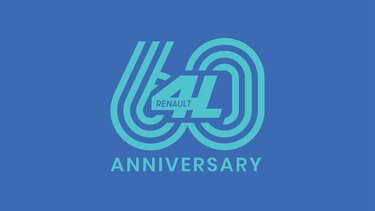
4L celebrates its 60th anniversary!
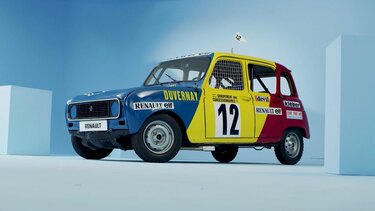
Iconic 4Ls in video
